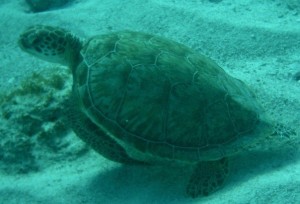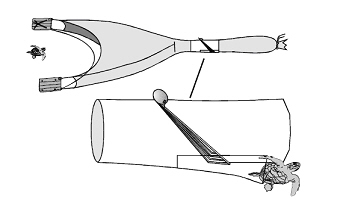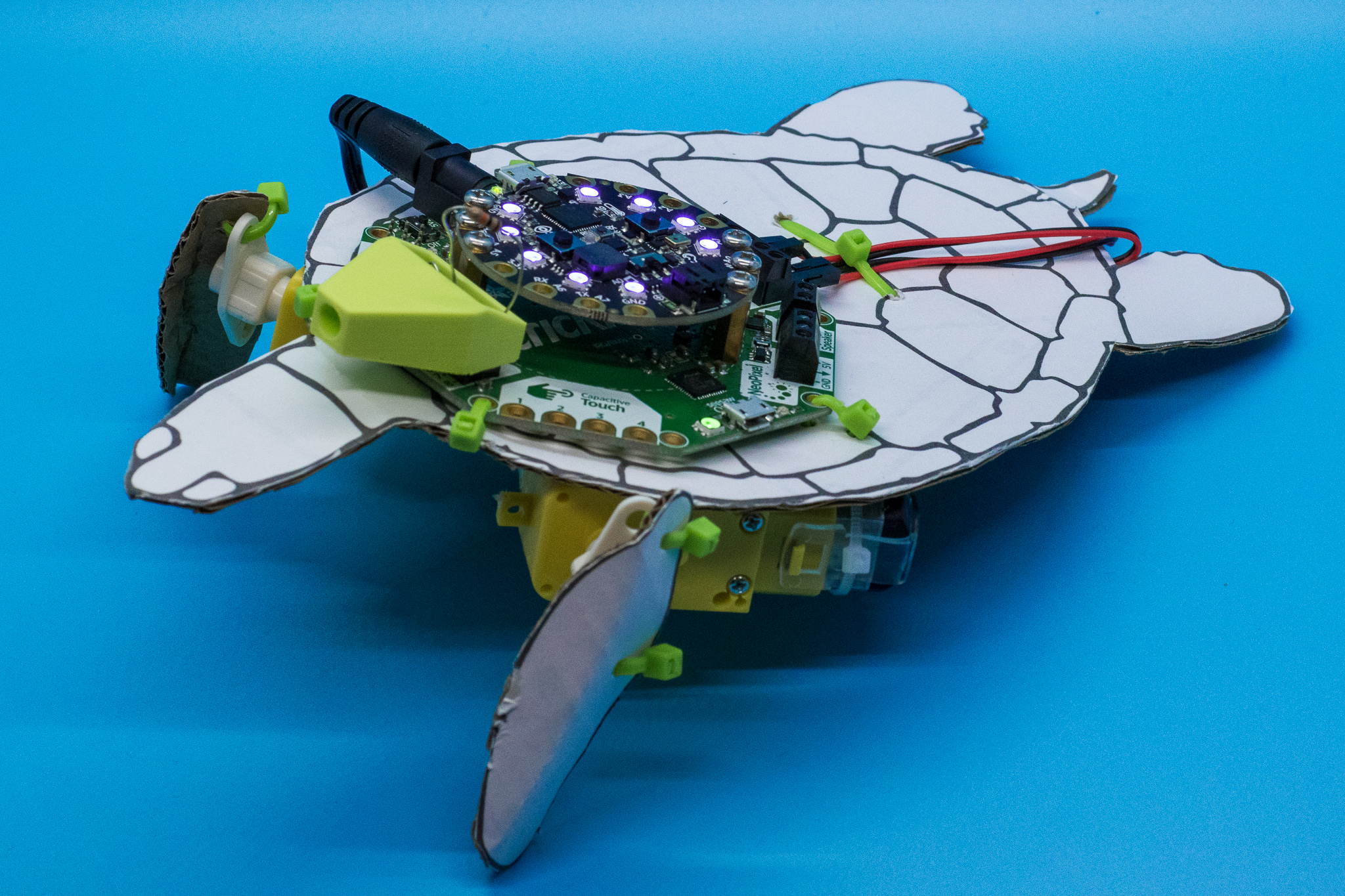 Conservation efforts often have an associated tradeoff, and many proposed solutions are shot down because the costs are perceived to be too high. A conservation policy that benefited a charismatic endangered species with very little cost should be popular and enthusiastically adopted. However, even though turtle excluder devices greatly reduce sea turtle mortality and have very low costs, they were vigorously opposed by shrimpers. Though many factors contributed to this opposition to turtle excluder devices, analysis of quotes from newspaper articles reveals that one of the major issues was a failure of the conservation community to educate and communicate with shrimpers.
Conservation efforts often have an associated tradeoff, and many proposed solutions are shot down because the costs are perceived to be too high. A conservation policy that benefited a charismatic endangered species with very little cost should be popular and enthusiastically adopted. However, even though turtle excluder devices greatly reduce sea turtle mortality and have very low costs, they were vigorously opposed by shrimpers. Though many factors contributed to this opposition to turtle excluder devices, analysis of quotes from newspaper articles reveals that one of the major issues was a failure of the conservation community to educate and communicate with shrimpers.
The problem
Most species of sea turtles are either threatened or endangered. Although they face many threats, a 1990 National Academy of Sciences study reached the conclusion that “drowning in shrimp trawls kills more sea turtles than all other human activities combined”. Trawling consists of dragging a large net behind a boat to catch shrimp. This fishing method has one of the highest bycatch rates of any used today, resulting in over 11 million metric tons of bycatch a year. Sea turtles breathe at the surface, and being trapped underwater in a net can be fatal if they aren’t freed in time. Adult loggerhead turtles can hold their breath for up to 45 minutes, but trawlers often wait up to four hours before hauling in their nets. This resulted in an estimated 48,000 sea turtles caught in trawl nets each year from 1973-1984 in U.S. waters, of which 11,000 died . Gulf of Mexico shrimping was particularly hard on loggerhead and kemp’s ridley sea turtles.
The solution
Fortunately, it is relatively easy to solve this problem. A shrimper modified an existing piece of technology known as a cannonball shooter (designed to keep cannonball jellyfish out of trawl nets), and the turtle excluder device (TED) was born. TEDs are extremely simple machines- whenever anything large enough gets to a certain part of the trawl net, a trapdoor opens, freeing the large animal (Figure 1). Shrimp are not large enough to open the trapdoor, so they remain in the net.
Figure 1: A diagram of a trawl net, TED, and sea turtle (NOAA 1995)
TEDs are as effective as they are simple. They reduce sea turtle mortaility by 97% (far more effective then reducing tow times) while costing shrimpers only 5-13% in reduced catch, a number that decreases with TED experience. After voluntary TED introduction efforts failed (only 2% of shrimpers chose to use them) and a series of ineffective intermediate steps, they were finally required year-round in 1992.
Opposition to TEDs
Although TEDs are simple, cheap, and effective, they were vigorously opposed by shrimpers. This opposition took many forms, including a public relations campaign referring to TEDs as “trawler elimination devices”, a Federal court case considered so important that it delayed the reauthorization of the Endangered Species Act, international legal proceedings before the World Trade Organization, and even a blockade of Gulf coast ports by shrimping vessels (including ramming Coast Guard vessels). Shrimpers made numerous arguments against TEDs, and while most were invalid, a few were based on facts.
The most common argument used by shrimpers was that TEDs made shrimping unprofitable. The Concerned Shrimpers of America claimed that TEDs result in 30-50% reduced shrimp catch . A scientific study found that actual shrimp catch reduction is between 5% and 13% The 5th circuit court determined that introducing TEDs fleetwide would result in an average annual cost of $5.9 million, significantly less than what groups like the Concerned Shrimpers of America claimed.
Many shrimpers disputed the high sea turtle mortality figures associated with trawling. The President of the Texas Shrimp Association claimed that the 11,000 turtles a year number was “vastly exaggerated” by scientists, and a shrimper called it a “trumped up charge”. Many shrimpers don’t think turtles are endangered because “they (scientists) don’t even know how many turtles are out there”. Some shrimpers claim that beachfront development, which destroys turtle nesting habitat, has a much greater effect than trawling. The National Academy of Sciences study, along with decades of sea turtle population research, easily refutes all of these claims.
A few shrimpers insisted that trawling can’t be harming turtles because there are no turtles in their area. One shrimper claimed never to have seen a sea turtle in 30 years except for on the wall of an environmentalist group’s office, and some claimed that they hadn’t heard of anyone encountering turtles. These claims are easily disproven.
Shrimpers also claimed that TED’s, which are basically heavy metal grates, are dangerous to have on board ships. However, not a single injury involving a TED has ever been reported.
Finally, shrimpers claimed that the use of TEDs put them at a disadvantage with foreign vessels not bound by U.S. environmental laws. Unlike the other arguments, this one was true, and this argument (combined with the port blockade) resulted in Congress passing the 1989 Sea Turtle Conservation Act. This law prohibited shrimp imports from countries that don’t use TEDs, and was considered to be a win for U.S. shrimpers, conservationists, and sea turtles. However, countries that didn’t use TED’s objected, and the dispute was referred to the World Trade Organization.
In 1998, the WTO ruled that the Sea Turtle Conservation Act violated international trade law, specifically the General Agreement on Tarriffs and Trade. One of the main arguments the WTO cited was that the United States shared TED technology and training primarily with neighbors and political allies, thus economically discriminating against countries that we didn’t consider allies.
Why the opposition?
In the end, the result that conservationists wanted was achieved, but the process was long and messy. An analysis of the reasons behind shrimper’s opposition to a simple, cheap, and efficient conservation initiative can help prevent similar troubles as new conservation initiatives are proposed.
One of the main problems with the entire TED campaign was that it was impersonal and antagonistic. The campaign to save the turtles was waged in the courtroom and in the media – most shrimpers never encountered a scientists or conservationist at all, and very few ever spoke to one. The President of the concerned shrimpers of America said that “we’d love for environmentalist to talk to real people in the industry and maybe we can help them understand what is happening”.
The antagonistic attitude of some environmentalist leaders towards shrimpers is clear. One referred to “unfounded and ill-conceived opposition to TED regulations” in a letter to the editor. Several alluded that shrimpers were dumb, saying “to reasonable persons, such statistics constitute overwhelming evidence (that shrimpers are killing turtles)” and “the facts speak for themselves and prove the shrimpers wrong”. Groups such as the Audobon society pushed for a national boycott of shrimp to “make shrimpers realize that it’s better to use TEDs”. This led to shrimpers feeling that the situation was “us against them”, with environmentalists trying to “shut us down”.
When a group feels threatened, they go on the defensive and are less likely to compromise. The “us vs. them” feelings generated by antagonistic environmental leaders led to some civil disobedience by shrimpers, who made claims like “it’s a bad law and we aint gonna live by it” and “this equipment will make outlaws out of all of us”. Some shrimpers were more extreme, saying “it’s not gonna be a peaceful situation, you ain’t seen nothing yet”, burning TEDs in protest, and in some cases even killing turtles intentionally. Even worse, the fear of legal repercussions alone is not a great motivator to follow a law that you don’t understand the reasons for. One shrimper claimed that he wouldn’t pull TEDs even if he “got two or three tickets or maybe spent some time in jail”.
Shrimpers had numerous misunderstandings about sea turtles, TEDs, and conservation science- all of which could easily have been corrected if conservationists talked to them. Many shrimpers falsely believed that TEDs were “like cutting a big hole in your net” and that they would result in an enormous loss of shrimp catch. Leaders of the shrimping industry claimed that “only buffoons are convinced that TEDs are necessary” and “everyone agrees that TEDs do not work” . Some believed that TEDs were an excuse for a “big government takeover”, and made statements like “they made the farmer inefficient by paying him not to farm…do they want to put us all on welfare?” and “I pray to god that these regulations are not just an excuse to protect your Federal budgets”. Many shrimpers simply did not respect science, and said things like “them diplomas aint worth nothing in the school of hard knocks”.
Conclusion: another way
Environmentalists fought for turtles in the courtroom and in the media, and very few ever spoke to shrimpers. This generated hostility and distrust among the shrimping community, which resulted in ignoring turtle conservation regulations, lobbying hard against them, and even violence. There is another way that environmentalists could have handled this situation. Environmentalists could have actually spoken to shrimpers instead of insulting and demonizing them through the media.
If environmentalists had taken the time to speak to shrimpers and hear their concerns, the “us. vs. them” argument wouldn’t have struck such a chord. If environmentalists had taken the time to explain the science to shrimpers, a lot of their misconceptions would have been cleared up and many would undoubtedly have agreed with the need for TEDs. Some would probably talk to their fellow shrimpers about TEDs and turtles, and some would probably have discouraged colleagues from violence.
There is no doubt that a TED or something like it is necessary to protect endangered sea turtles. TEDs should definitely be required by law because there will always be people who don’t care about conservation regardless of how much time is spent explaining it to them. However, if the environmental community handled the TED issue in a personal and respectful way, there probably would have been much less resistance from shrimpers. Less resistance from shrimpers would have meant, among many other things, that conservation groups would have had much more time, money, and resources to spend on other issues. Environmentalists also would have new allies in the fight to save the environment instead of lifelong enemies, and with the way the planet is deteriorating, we can use all the help we can get.

Chambers, P., & Kohn, R. (2001). Environmental Barriers to Trade: The Case of Endangered Sea Turtles Review of International Economics, 9 (1), 123-132 DOI: 10.1111/1467-9396.00268
Crowder, L., Crouse, D., Heppell, S., & Martin, T. (1994). Predicting the Impact of Turtle Excluder Devices on Loggerhead Sea Turtle Populations Ecological Applications, 4 (3) DOI: 10.2307/1941948
Lewison, R., Crowder, L., & Shaver, D. (2003). The Impact of Turtle Excluder Devices and Fisheries Closures on Loggerhead and Kemp’s Ridley Strandings in the Western Gulf of Mexico Conservation Biology, 17 (4), 1089-1097 DOI: 10.1046/j.1523-1739.2003.02057.x
Yaninek, K (1995). Turtle Excluder Device Regulations: Laws turtles can lie with North Carolina Law Journal


I’ve been raised on the bayous of Louisiana and at 35 years old I have never been told of, seen, or exposed to any fisherman having a sea turtle on his boat. The whole concept is designed by “biologist” that are forced to push political agendas or lose their jobs. Fisherman are neither dumb, nor are they incompetent. Fishermen do understand that the federal government has an “imports” fetish. And the entire “TEDS” issue is just a way to stop a thriving industry. Fishermen know it is illegal to stop anyone from working in this country, however, it is feasible to create hard regulations in such a way that a fisherman can not survive and are “forced” to quit. Such evil tactics….shame on anyone who agrees with this article filled with lies.
There are literally tens of thousands of photos, videos, interviews with shrimp fishermen, scientific reports, and government reports clearly and unequivocally documenting that sea turtles were killed in large numbers by shrimp trawl nets before TEDs were introduced. To claim otherwise is just silly.
I’ve been out sporadically with shrimp boats for 3 seasons and have at least twice seen turtles caught in nets. Which is why personal anecdotes don’t trump data.
I’ve never observed any pictures. I’ve talked to fisherman all day every day. And, as far as your government reports (which probably are a great plan B if you run out of toilet paper) Also, I’ve been told by a biologist after a conference in baton rouge that he could not declare the certain date requested to open the shrimping season because and I c quote “it clashed with the political winds, and he would lose his job.” So your “data” is likely skewed toward your personal views or the views of whomever is writing your check.
Here’s several: http://news.nationalgeographic.com/news/2010/04/photogalleries/100406-sea-turtles-killed-conservation-letters-pictures/#/green-sea-turtles-netted_18296_600x450.jpg
But you opinions are skewed toward your personal views or the views of whomever is writing your check, so it’s doubtful you’ll accept anything other than what you want to believe. Denial is a dangerous thing for fishermen and fisheries.
My opinions are not skewed toward my personal beliefs. Understand this. I’ve lived the life and feel the effects of what you( meaning “biologist”) done daily. I was raised in the fishing community you destroyed. Thanks to you I had to can no longer take over the family business and continue a legacy.to support my family, however, the older fisherman are not so lucky.. You’re whole “save the turtle” idea is very noble and it looks so nice on a reume doesn’t it. However, those pictures are not from south Louisiana. And your position on the TED’s and turtles have completely shut down a town of 10,000 people’s way of life. You have damaged a local heritage and pinned claims of killing turtles on fisherman that have likely never caught one which is where the saddness and frustration comes into play. You railroaded a harmless culture to its demise in order to accept a feather in your cap and tell all your associates “Hey, Look what I did!” You’ve ruined the lives of fisherman and their families that have done this for their entire lives and are now jobless or on welfare to survive They didn’t have to be in this situation. You’ve damaged the pride and culture of your fellow americans….but you saved a turtle!! I wish I could make such narrow minded scientist or “biologist” understand the reality and consequences of their actions. How could you look at yourself in a mirror knowing that your rant about TED’s and Louisiana fisherman catching a turtle is false?? You probably don’t get it..and it’s likely that you don’t care.
That whole rant is nothing but a diatribe tainted by personal vendetta and a false view of reality.
What’s truly bizarre is that, in the comment thread of a post advocating that biologists and environmentalist should work with fishermen and their communities to find mutually beneficial solution, you claim that biologist are actively trying to destroy your way of life for fun. The truth is literally right in front of you and you choose to ignore it. What a waste.
It’s nothing personal, and nice try to skew my statements as a meaningless rant. But I still haven’t seen any turtles in Louisiana waters.
It’s sad when someone that has no real experience in an industry creates pencil-whipped data to create rules to destroy a local heritage of fellow Americans. I know biologist don’t care. I know that they make their pay check through grants and donations to “study” something. And that data must follow the political winds or you lose the next grant. You don’t have to admit it, and you may not want to hear it, but we all know who the real waste is….
On a whim, I decided to check out the IP address of our dear friend, CajunGuy (something we usually don’t do, but his comments were raising a couple red flags). Curiously, it seems as though, instead of being in Louisiana, he’s writing to us from just outside the DC Beltway. Not terribly incriminating on it’s own, as perhaps he just got sick of the bayou. What’s more interesting is that he’s coming to us live from the ConocoPhillips web servers. If you’re going to shill for an oil and natural gas company, at least have the decency to mask your domain.
One must wonder, has he ever even been to Louisiana, or is he just being paid to shill for deregulation in oil rich regions?
Either way, he’s not welcome here. Parroting aside, we’re not interested in wasting our time with industry shills.